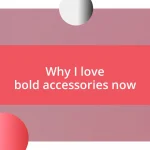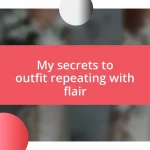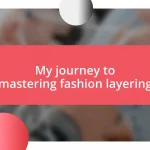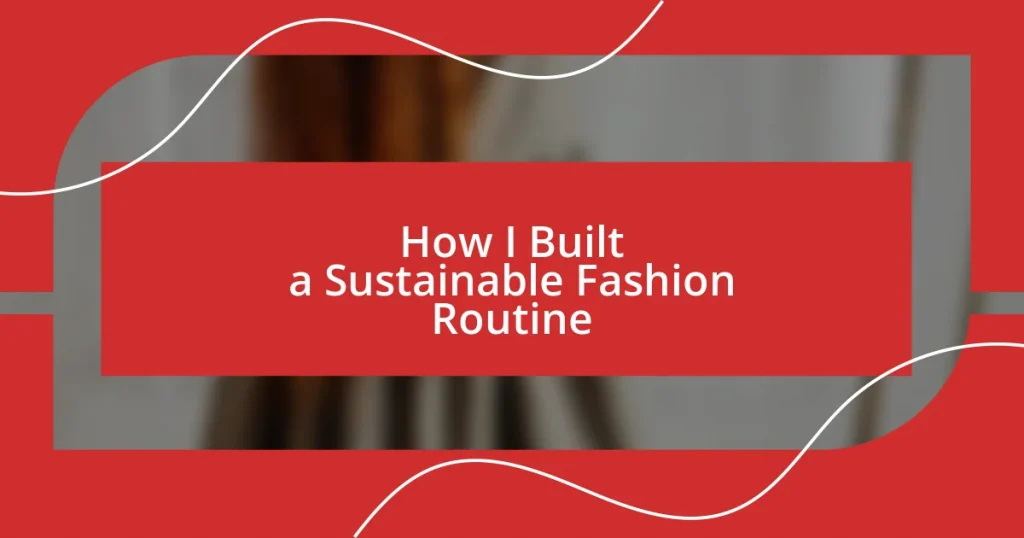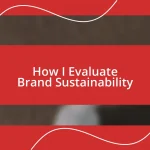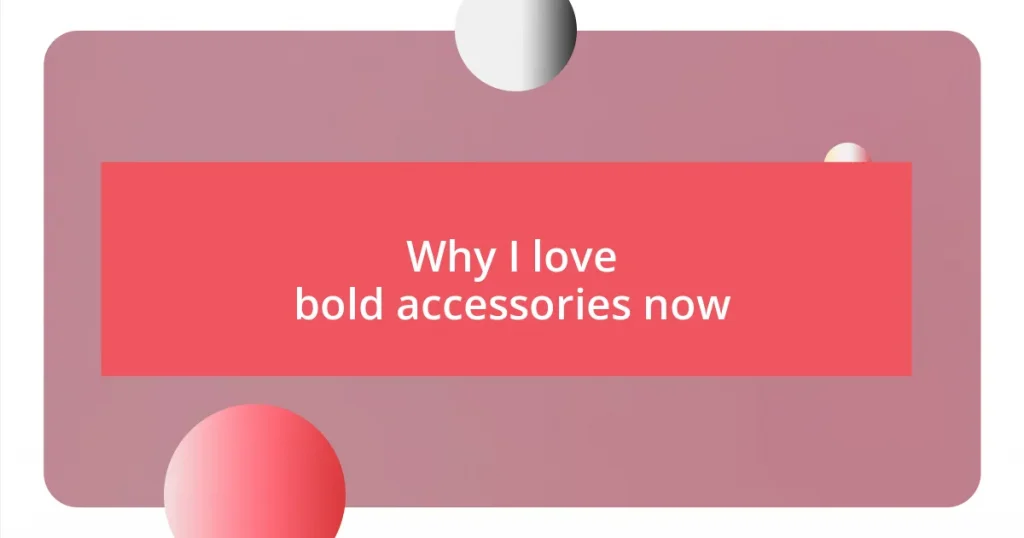Key takeaways:
- Sustainable fashion hinges on ethical foundations, prioritizing quality, longevity, and transparency in sourcing.
- Creating a personal style and evaluating wardrobe essentials fosters a curated, cohesive collection that reflects individual values and minimizes waste.
- Practicing mindful shopping and maintaining/recycling clothing enhances awareness of environmental impact, promoting a deeper connection to one’s wardrobe.

Understanding Sustainable Fashion Principles
Sustainable fashion goes beyond just eco-friendly fabrics; it’s about creating an ethical foundation for the entire industry. I remember the moment I realized that every purchase impacts someone’s life, from the designer to the worker in the factory. When we think about fashion, do we consider the story behind each piece, or is it just about the style?
Another key principle is the importance of longevity in our wardrobe. I used to buy clothes that quickly fell apart, but now I choose quality over quantity, investing in pieces that will last. It’s emotional to see how a well-cared-for item can hold memories, rather than just being another item to discard.
Lastly, transparency in sourcing is crucial. Understanding where our clothing comes from can be eye-opening. I once discovered that a favorite shirt was made from ethically sourced cotton, and it made me appreciate the brand so much more. Isn’t it comforting to know that your clothing choices reflect your values?
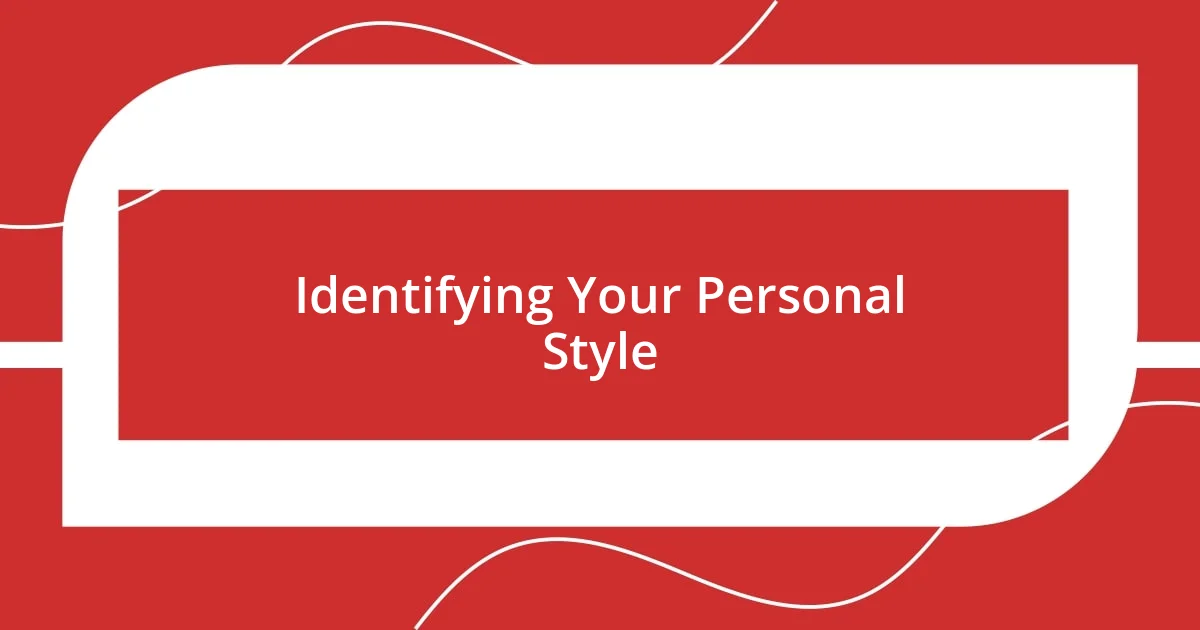
Identifying Your Personal Style
Identifying your personal style can be a rewarding journey. I used to feel overwhelmed by trends, often buying clothes that didn’t resonate with me. Slowly, I began to understand what truly represented my personality. Now, I gravitate toward pieces that reflect who I am, not just what is currently popular. It’s liberating to curate a wardrobe that feels authentic.
To help with this process, consider these questions:
- What colors make me feel confident?
- Which fabrics do I enjoy wearing the most?
- Are there patterns or prints that resonate with my personality?
- Do I prefer a casual, formal, or a mix of styles?
- Which accessories can enhance my outfits and express my uniqueness?
By reflecting on these aspects, you can start to build a cohesive and personal wardrobe that not only looks good but makes you feel good inside as well.
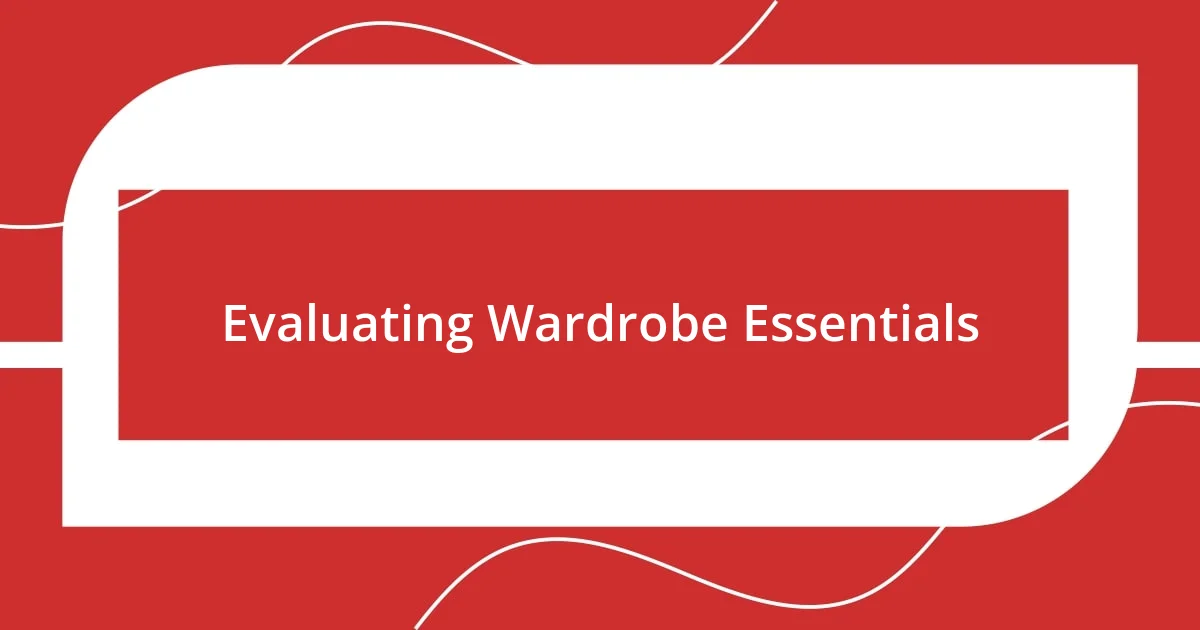
Evaluating Wardrobe Essentials
Evaluating wardrobe essentials is an essential part of creating a sustainable fashion routine. Over the years, I learned to assess each item in my closet not just for style, but for functionality and sustainability. It became a personal ritual to ask myself, “Does this piece serve a purpose in my life?” I remember the satisfaction of clearing out clothes that no longer fit my needs or values. The experience felt refreshing, almost like shedding a burden.
Moreover, I found it helpful to categorize my clothing into essentials that can be mixed and matched. This made getting dressed a more creative and mindful process. I used to have countless items that were rarely worn, simply taking up space. Now, my wardrobe includes versatile staples that effortlessly create various outfits. For instance, a classic white shirt can transition from a casual brunch to a formal meeting with just a change of accessories.
Evaluating the seasonality of items is another crucial factor. I used to hold onto clothes for sentimental reasons or because they were trendy, but I’ve learned that practicality prevails. Seasonal evaluation helps me determine what I truly wear and love.
| Wardrobe Essential | Functionality |
|---|---|
| Classic White Shirt | Versatile for multiple occasions |
| High-Quality Jeans | Durable and fits multiple styles |
| Little Black Dress | Suitable for various events |
| Comfortable Shoes | Essential for daily wear |
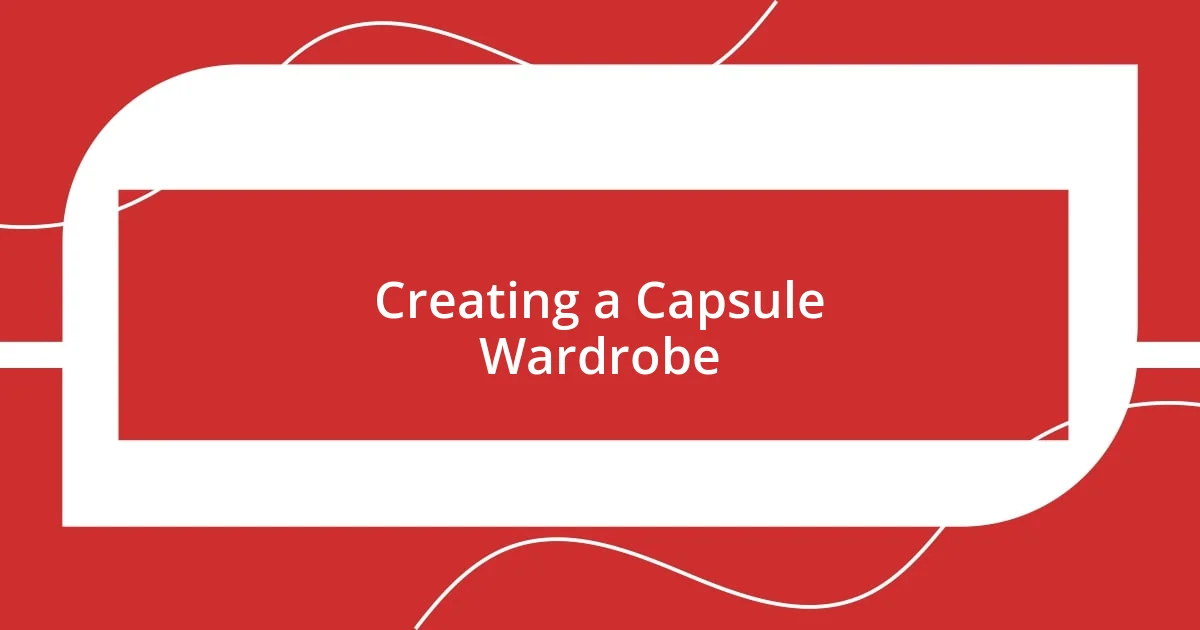
Creating a Capsule Wardrobe
Creating a capsule wardrobe has been one of the most rewarding decisions I’ve ever made. I remember the moment I realized how liberating it felt to simplify my closet. Each piece I chose with intention brought me joy and purpose. It’s almost like curating a little gallery of my favorite outfits—every item tells a story.
In my experience, starting with a neutral color palette helped me immensely. I chose shades that resonate with my personal style, allowing for endless combinations. For instance, my love for earth tones led me to a collection of warm beiges and deep greens. I often ask myself, “What can I wear that will make me feel confident today?” This question guides my wardrobe choices and reminds me to pick items that uplift me.
Over time, I’ve learned to embrace the idea that less truly is more. I felt such a sense of accomplishment when I realized I could create multiple outfits from just a few versatile pieces. For example, my favorite black blazer can effortlessly transform a casual t-shirt and jeans into a polished look. Have you tried mixing your favorites for different occasions? The thrill of new combinations keeps my wardrobe fresh and exciting.

Incorporating Sustainable Brands
In my journey to incorporate sustainable brands, I stumbled upon the joys of ethical shopping. One day, while browsing a local boutique, I discovered a designer whose values matched mine—fair labor practices and eco-friendly materials. That moment was a turning point; it felt good to know that my purchase supported a business committed to making a positive impact. Have you ever had that spark of joy when you find a brand that resonates with your personal ethics?
Transitioning to sustainable brands also meant being more mindful about my purchases. I became intentional about researching each label, checking their production practices, and understanding their environmental footprint. It’s easy to get caught up in trends, but knowing the story behind each piece made my wardrobe feel like a collection of values. I still remember receiving my first order from an eco-conscious brand; unboxing it felt like uncovering a treasure that I could wear with pride and confidence.
I also found that incorporating sustainable brands is not just about shopping; it’s about embracing a new mindset. By choosing quality over quantity, I began to appreciate the craftsmanship and thoughtfulness behind each piece. For instance, when I invested in a beautifully made Fair Trade bag, it became more than just an accessory; it represented a choice to support artisans and sustainable practices. How do you feel about the pieces you add to your wardrobe? This emotional connection deepens my appreciation for sustainable fashion and encourages me to share these brands with friends and family.
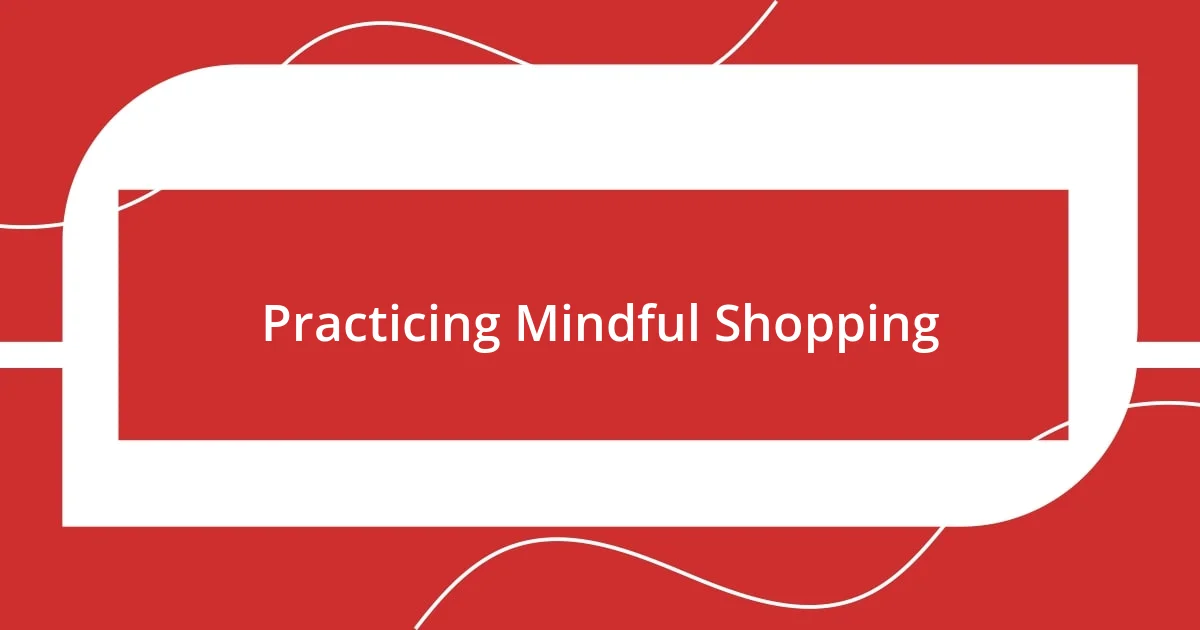
Practicing Mindful Shopping
Practicing mindful shopping transformed the way I approach fashion. I recall a time when I stood in a store, overwhelmed by choices, and I realized I was buying things purely out of habit rather than need. Now, before making a purchase, I pause and ask myself, “Will this item add value to my wardrobe?” This simple question has saved me from countless impulse buys and has turned shopping into a deliberate act of self-expression.
Each shopping trip is now an opportunity for reflection, where I consider not only how a piece fits into my style but also its environmental impact. I remember purchasing a beautiful dress made from sustainable fabric; the moment I tried it on, I felt both beautiful and responsible. Isn’t it amazing how knowing the origin of your clothes can enhance your pride in wearing them? I’ve found that investing in sustainable pieces gives me a deeper connection to my wardrobe, making each item feel truly special.
It’s the little rituals that have made the biggest difference. For instance, I started creating a list of essentials before heading out, which helps me stay focused and avoid distractions. This practice has turned shopping into a mindful experience rather than a mindless chore. Can you relate to that moment of clarity when you realize that each choice reflects your values? It feels incredibly empowering to curate a wardrobe that not only looks good but also aligns with my commitment to sustainability.

Maintaining and Recycling Clothing
Maintaining and recycling clothing has become a crucial part of my sustainable fashion routine. Whenever I find myself with an item that no longer sparks joy, I pause to reflect on its journey. I remember the first time I repaired a small tear in my favorite sweater; instead of discarding it, I took the time to stitch it up. That moment wasn’t just about the sweater; it felt like I was extending its life and minimizing waste. Have you ever realized how a little care can rejuvenate your wardrobe?
I also make it a habit to clean my clothes with sustainability in mind. For instance, I switched to eco-friendly detergents and only wash when necessary to reduce water usage. This change has not only kept my clothes looking vibrant but has also allowed me to feel good about my choices. I can vividly recall the first time I used a refillable detergent system; knowing I was avoiding single-use plastic gave me a little thrill. Isn’t it satisfying to think that small actions can contribute to a healthier planet?
Recycling clothing has opened my eyes to the broader impact of fashion. I’ve started donating items that no longer serve me, but I’ve also explored creative reuses. One memorable project was transforming an old pair of jeans into a chic tote bag; it felt innovative and eco-friendly to give new life to something I would have otherwise thrown away. How many hidden treasures do you think are waiting to be repurposed in your closet? Embracing these practices has shifted my relationship with clothing from disposable to meaningful, and I encourage everyone to consider the potential of their wardrobe.

